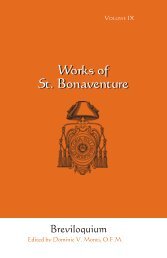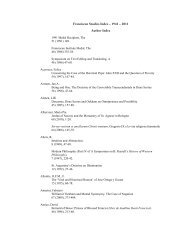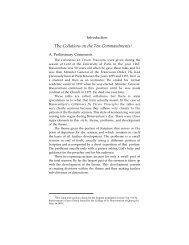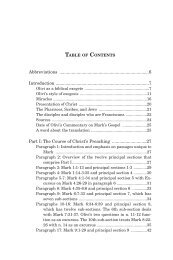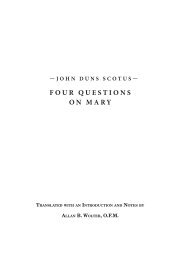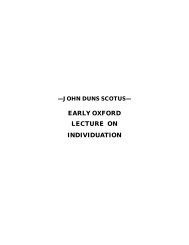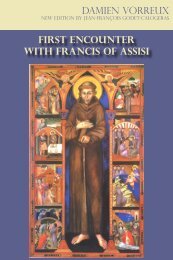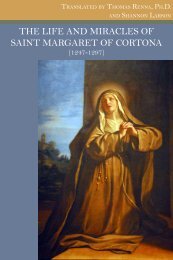Francis of Assisi and the Feminine - Franciscan Institute Publications
Francis of Assisi and the Feminine - Franciscan Institute Publications
Francis of Assisi and the Feminine - Franciscan Institute Publications
You also want an ePaper? Increase the reach of your titles
YUMPU automatically turns print PDFs into web optimized ePapers that Google loves.
10 FRANCIS OF ASSISI AND THE FEMININE<br />
Historians exercise <strong>the</strong>ir craft. They historicize. There are<br />
many forgotten figures we would like to resurrect from history,<br />
from <strong>the</strong> obscurity <strong>of</strong> <strong>the</strong> times in which <strong>the</strong>y have<br />
been set. Efforts must be made to retrieve <strong>Francis</strong>, <strong>the</strong> w<strong>and</strong>erer,<br />
bro<strong>the</strong>r to <strong>the</strong> wind. However, a web has been woven<br />
<strong>and</strong> wafted, into an ever-tighter net. From out <strong>of</strong> time, <strong>Francis</strong><br />
<strong>of</strong> <strong>Assisi</strong>, son <strong>of</strong> Pietro di Bernardone who was born in<br />
1181 <strong>and</strong> died on October 3, 1226, returns to time. He fills<br />
his times completely, always holding center stage.<br />
The entire Middle Ages are subsumed in <strong>Francis</strong>, or such<br />
will be <strong>the</strong> impression <strong>of</strong> <strong>the</strong> readers who become immersed<br />
in <strong>Francis</strong>can sources. The more <strong>the</strong>y delve into <strong>the</strong>m, <strong>the</strong><br />
more plentiful materials <strong>the</strong>y will find, concentrated in <strong>the</strong><br />
writings <strong>and</strong> legends, to build <strong>the</strong> man from <strong>Assisi</strong> into a representative<br />
<strong>of</strong> his time <strong>and</strong> period. Medieval life with its<br />
l<strong>and</strong>scapes <strong>of</strong> wild solitude, unchanging rusticity <strong>and</strong> bustling<br />
cities, <strong>and</strong> its social order comprising merchant classes<br />
<strong>and</strong> ambitious aristocracy, self-satisfied wealth alongside absolute<br />
poverty, clerics <strong>and</strong> laity, literate <strong>and</strong> illiterate. In <strong>the</strong><br />
life <strong>of</strong> <strong>Francis</strong>, <strong>the</strong> quintessential medieval man, we find <strong>the</strong><br />
paradoxes <strong>of</strong> <strong>the</strong> period, for which he instinctively found<br />
<strong>the</strong> syn<strong>the</strong>sis – unparalleled conformity to <strong>the</strong> gospel message.<br />
He was a herald <strong>of</strong> <strong>the</strong> future from <strong>the</strong> Reformation to<br />
today’s struggle against poverty, which can be compared<br />
with 13th century misery. We find ourselves new <strong>and</strong> willing<br />
victims <strong>of</strong> <strong>the</strong> extraordinary <strong>Francis</strong>can propag<strong>and</strong>a,<br />
which has celebrated ever more resolutely <strong>the</strong> conformity <strong>of</strong><br />
<strong>the</strong> Poverello “to <strong>the</strong> poor, naked, suffering crucified Christ,<br />
suspended on <strong>the</strong> cross.” 1 <strong>Francis</strong> is not a-historical but<br />
ra<strong>the</strong>r trans-historical because <strong>of</strong> his capacity to encapsulate<br />
<strong>and</strong> assume humanity <strong>and</strong> human history. In what appears<br />
like a contradiction: <strong>the</strong> uniqueness <strong>of</strong> <strong>Francis</strong> is found in<br />
his similarity; his identity in being identical.<br />
Like Christ his model, captured initially in <strong>the</strong> writings<br />
<strong>of</strong> <strong>the</strong> four evangelists before becoming <strong>the</strong> center <strong>of</strong> widely<br />
conflicting interpretations, <strong>the</strong>re are many different interpretations<br />
<strong>of</strong> <strong>Francis</strong>. This is evident in <strong>the</strong> <strong>Francis</strong>can<br />
sources <strong>the</strong>mselves, which, since <strong>the</strong> first century <strong>of</strong> <strong>the</strong> Or-



